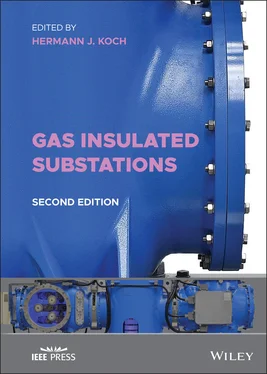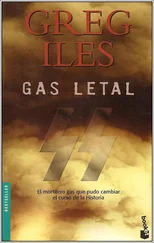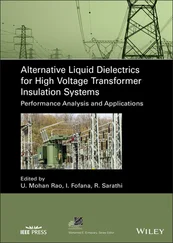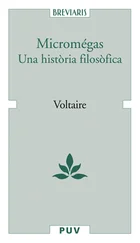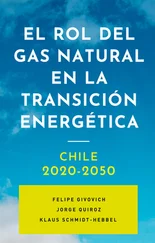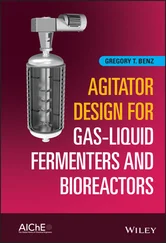Gas Insulated Substations
Здесь есть возможность читать онлайн «Gas Insulated Substations» — ознакомительный отрывок электронной книги совершенно бесплатно, а после прочтения отрывка купить полную версию. В некоторых случаях можно слушать аудио, скачать через торрент в формате fb2 и присутствует краткое содержание. Жанр: unrecognised, на английском языке. Описание произведения, (предисловие) а так же отзывы посетителей доступны на портале библиотеки ЛибКат.
- Название:Gas Insulated Substations
- Автор:
- Жанр:
- Год:неизвестен
- ISBN:нет данных
- Рейтинг книги:3 / 5. Голосов: 1
-
Избранное:Добавить в избранное
- Отзывы:
-
Ваша оценка:
- 60
- 1
- 2
- 3
- 4
- 5
Gas Insulated Substations: краткое содержание, описание и аннотация
Предлагаем к чтению аннотацию, описание, краткое содержание или предисловие (зависит от того, что написал сам автор книги «Gas Insulated Substations»). Если вы не нашли необходимую информацию о книге — напишите в комментариях, мы постараемся отыскать её.
Gas Insulated Substations (GIS)
Gas Insulated Substations — читать онлайн ознакомительный отрывок
Ниже представлен текст книги, разбитый по страницам. Система сохранения места последней прочитанной страницы, позволяет с удобством читать онлайн бесплатно книгу «Gas Insulated Substations», без необходимости каждый раз заново искать на чём Вы остановились. Поставьте закладку, и сможете в любой момент перейти на страницу, на которой закончили чтение.
Интервал:
Закладка:
Thanks to authors and reviewers of the second edition GIS book. Thank you to the 20 authors of the 1st edition Arnaud Ficheux, Arun Arora, Charles Hand, Dave Lin, Dave Solhtalab, Devki Sharma, George Becker, Hermann Koch, James Massura, John Boggess, John Brunke, Jorge Márquez‐Sánchez, Noboru Fujimoto, Peter Grossmann, Pravakar Samanta, Ravi Dhara, Richard Jones, Venkatesh Minisandram, William Labos, and Xi Zhu. Thank you for 10 authors Coboyo Bodjona, Dave Giegel, Dave Mitchell, Dave Solthalab, George Becker, Hermann Koch, Maria Kosse, Pathik Patel, Richard Jones, and Xi Zhu and Aron Heck, and 7 coauthors Dirk Helbig, George Becker, Mark Kuschel, Peter Grossmann, Uwe Riechert, and Vipul Bhagat for their contribution of new text to the second edition.
Thank you to the many reviewers of text with their recommendations to improve the writing of the text, making it easier to read and understand. If you find something wrong, please contact the editor for improvement. Thank you to the 29 reviewers of the 1st edition text Arnaud Ficheux, Chuck Hand, Dave Giegel, Dave Solhtalab, David Lin, Devki Sharma, Richard Jones, Eduard Crockett, Ewald Warzecha, George Becker, Hermann Koch, James Massura, John Brunke, Linda Zhao, Markus Etter, Noboru Fujimoto, Patrick Fitzgerald, Peter Grossmann, Phil Bolin, Pravakar Samanta, Ravi Dhara, Ricardo Arredondo, Richard Jones, Scott Scharf, Shawn Lav, Toni Lin, Venkatesh Minisandram, and Xi Zhu.
After the 1st edition had been published some correction and editorial changes were needed to improve the text which was done by Arnaud Ficheux, Bala Kotharu, Coboyo Bodyona, Devki Sharma, Richard Jones, George Becker, Hermann Koch, James Massura, John Brunke, Michael Novev, Pablo Gonzales Toza, Pathik Patel, Patrick Fitzgerald, Pravakar Samanta, Ryan Stone, and Scott Scharf, thank you for your contribution.
The new text of the second edition was review by Arnaud Ficheux, Aron Heck, Bala Kotharu, Denis Steyn, Dirk Helbig, George Becker, Gerd Ottehenning, Hermann Koch, James Massura, John Brunke, Mark Kuschel, Michael Novev, Nick Matone, Pathik Patel, Patrick Fitzgerald, Petr Rudenko, Robert Lüscher, Ryan Stone, Scott Scharf, and Stefan Schedl, thank you for improving the text and eliminate failures.
Thank you to Siemens‐Energy, GE, Hitachi‐ABB, Mitsubishi, AZZ, Tech S Corp, Kinectrics, Power Engineers, Burns & McDonnell, National Grid, United Illuminating, Pacific Gas & Electric, Dominion, G&E, Southern California Edison the use of photos and graphics.
The authors thank IEEE PES for their permission to reproduce information related to the IEEE Standards C37 series with the main focus on C37.122, C37.122.1, C37.122.2, and C37.122.3 as indicated in the subclause references. Further information on IEC is available from www.ieee.org.
Thanks to International Electrotechnical Commission (IEC) for permission to reproduce information of IEC 62271‐203, ‐203, and ‐209. All such extracts are copyright of IEC, Geneva, Switzerland. All rights reserved. Further information on IEC is available from www.iec.ch.
The authors also thanks CIGRE (International Council of Large Electric Systems) for their permission to reproduce information from their Technical Brochures as indicated in the subclause references. Further information on www.CIGRE.org.
IEEE, IEC, and CIGRE have no responsibility for the placement and context in which the extracts and contents are reproduced by the authors, nor in any way responsible for the other content or accuracy therein.
Thanks to John Wiley & Sons and the editing team for their professional work and publishing in a nice‐looking way.
Thank you to my family with my wife Edith, my children Christian and Katrin, their partners Britta and Peter, and my grandson Lukas for the patience to give me the time to work on the book.
The editor and all authors wish you, the reader of the GIS book to find informative and useable information for your work on high voltage substation design.
1 Introduction
Authors: Hermann Koch, John Brunke
Reviewers: Phil Bolin, Devki Sharma, Jim Massura, George Becker, Scott Scharf, and Michael Novev
1.1 General
This book is based on the tutorial and panel sessions presented by the subject matter experts (SME) of gas‐insulated substations in the working group K2 of the Institute of Electronics and Electrical Engineer (IEEE) Substations Committee. Gas‐insulated substations (GIS), for alternative current (AC) were invented in the early 1960s with the first projects in the mid‐1960s in the United States and Europe. In Japan, research and development for GIS started from 1963 followed by the practical application of 84 kV GIS (1968).
With thousands of installed bays, of GIS today, we can look back to a wide range of experiences gained in very different cases of applications.
The IEEE Substations Committee created the GIS Subcommittee K0 more than twenty‐five years ago and since then this subcommittee has continuously worked on standards and guides in the field of GIS technology and application. About twenty‐five standards and guides related to the GIS have been published to‐date, with continuous revision work in progress on all documents and preparation of new documents.
Around the year 2000, the SME of the GIS Subcommittee started to collect information on GIS and developed a tutorial on Gas‐Insulated Substations (GIS) and Transmission Lines (GIL). This working group is numbered as K2 in the GIS Subcommittee and continually works to come up with new tutorials on different subjects associated with GIS.
1.1.1 Organization
The organization of the Substations Committee was developed over the last decades with the focus being on any equipment and systems related to substations. In Table 1.1, the scope of the subcommittees of the substations committee is shown and in Figure 1.1, the organization of the Substations Committee is shown.
IEEE PES Substations Committee has five subcommittees. Three subcommittees are for transmission and distribution (T&D) substations in physical electrical design (D0), physical civil design (E0), and grounding lightning (G0). One subcommittee for power electronic in T&D substations and one for gas‐insulated switchgear (GIS) (K0). For the scope of the subcommittees, see Table 1.1. The administrative substation committee (B0) is represented by the chair, vice‐chair, secretary, past‐chair and holds subcommittees for transactions editor, awards (H0), standards (S0), and meetings (M0).
Table 1.1 Scope of subcommittees of the substations committee
| D0: | Transmission and distribution substation design for a medium‐voltage substation in the range of 1 kV up to and including 52 kV and a high‐voltage substation above 52 kV |
| E0: | Transmission and distribution of substation operations for medium‐voltage substations in the range of 1 kV up to and including 52 kV and high‐voltage substations for above kV |
| G0: | Transmission and distribution of substation grounding and lightning |
| I0: | High‐voltage power electronics stations for DC equipment above 1.5 kV to be installed in a substation or converter station like AC/DC converters, coils, filters, grounding, and software for control and protection |
| K0: | Gas‐insulated substations for AC high‐voltage equipment above 1 kV of switchgear, disconnectors, and ground switches (GIS) and power transmission (GIL) |
The standardization work is split into working groups of the five subcommittees which carry the responsibility for standards and guides. D0 for physical electrical design of substations has seven active working groups: Electrical Clearance D1 (IEEE 1427), Cable System in Substations D2 (IEEE 525), Bus Design D3 (IEEE 605), Seismic requirements to Substation Equipment D4 (IEEE 693), Flexible Bus works in Substations D5 (IEEE 1527), Turnkey Substations D8 (IEEE 1267), and AC/DC Power Supply Systems in Substations D9 (IEEE 1818).
Читать дальшеИнтервал:
Закладка:
Похожие книги на «Gas Insulated Substations»
Представляем Вашему вниманию похожие книги на «Gas Insulated Substations» списком для выбора. Мы отобрали схожую по названию и смыслу литературу в надежде предоставить читателям больше вариантов отыскать новые, интересные, ещё непрочитанные произведения.
Обсуждение, отзывы о книге «Gas Insulated Substations» и просто собственные мнения читателей. Оставьте ваши комментарии, напишите, что Вы думаете о произведении, его смысле или главных героях. Укажите что конкретно понравилось, а что нет, и почему Вы так считаете.
